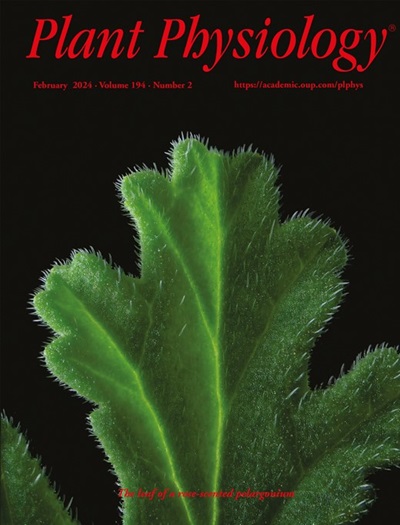在2种对比针叶树的根中发现了大量电容。
IF 6.5
1区 生物学
Q1 PLANT SCIENCES
引用次数: 0
摘要
高速率的光合作用需要大量的水输送到冠层,以补充蒸腾作用损失的水分。除了直接从土壤中汲取水分外,茎电容已被确定为另一种水源,特别是在瞬态蒸腾状态下。然而,由于方法上的限制,对根系电容进行量化具有挑战性,因此关于根系对植物电容的潜在贡献的信息很少。在本研究中,我们提出了一种测量根系储水能力并评估其对日间蒸腾贡献的方法。我们使用光学树木计获得了2种不同针叶树种——牡蛎湾松(Callitris rhomboidea)和蒙特雷松(Pinus radiata)的水势和蒸腾的原位测量,从而量化了植物水分亏缺的日变化。我们采用改进的流量计分别测量了地下和地上系统的再水化动力学。我们观察到,在蒸腾瞬态变化期间,两种植物的根电容是水分需求的主要供给者。值得注意的是,菱形蒿的地下总电容大于地上总电容,而辐射蒿的地下总电容与地上总电容相差不大。我们的研究结果强调了在水力模型中测量和包括地下电容的重要性,以准确预测植物的日水分状况和气孔行为。本文章由计算机程序翻译,如有差异,请以英文原文为准。
Substantial capacitance found in the roots of 2 contrasting conifer species.
High rates of photosynthesis require abundant water delivered to the canopy to replace water lost to transpiration. In addition to water drawn immediately from the soil, stem capacitance has been identified as an additional water source, particularly during transient transpiration states. However, little information is available about the potential of roots to contribute to plant capacitance because methodological constraints have made it challenging to quantify root capacitance. In this study, we present a method to measure the water storage capacity of the root system and assess its contribution to daytime transpiration. We used an optical dendrometer to obtain in situ measurements of water potential and transpiration in 2 contrasting conifer species, Oyster Bay pine (Callitris rhomboidea) and Monterey pine (Pinus radiata), allowing us to quantify diurnal changes in plant water deficit. We employed a modified flow meter to gauge the rehydration kinetics of the below-ground and above-ground systems separately. We observed that root capacitance is a major supplier to the water demands during transient changes in transpiration for both species. Notably, the total below-ground capacitance exceeded the above-ground capacitance in C. rhomboidea, while the 2 capacitances were similar in P. radiata. Our findings highlight the importance of measuring and including below-ground capacitance in hydraulic models to accurately predict diurnal plant water status and stomatal behavior.
求助全文
通过发布文献求助,成功后即可免费获取论文全文。
去求助
来源期刊

Plant Physiology
生物-植物科学
CiteScore
12.20
自引率
5.40%
发文量
535
审稿时长
2.3 months
期刊介绍:
Plant Physiology® is a distinguished and highly respected journal with a rich history dating back to its establishment in 1926. It stands as a leading international publication in the field of plant biology, covering a comprehensive range of topics from the molecular and structural aspects of plant life to systems biology and ecophysiology. Recognized as the most highly cited journal in plant sciences, Plant Physiology® is a testament to its commitment to excellence and the dissemination of groundbreaking research.
As the official publication of the American Society of Plant Biologists, Plant Physiology® upholds rigorous peer-review standards, ensuring that the scientific community receives the highest quality research. The journal releases 12 issues annually, providing a steady stream of new findings and insights to its readership.
 求助内容:
求助内容: 应助结果提醒方式:
应助结果提醒方式:


